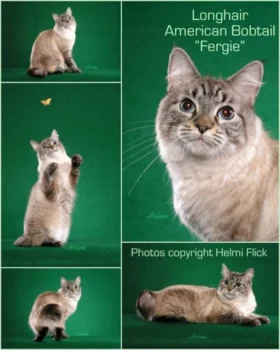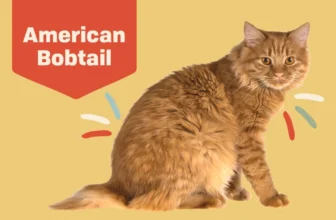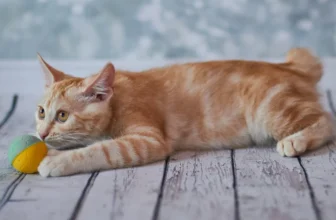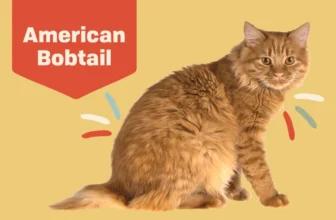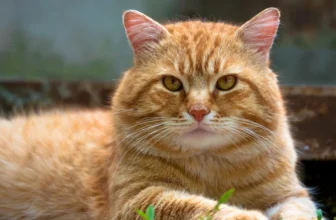The American Bobtail breed has always been known for its distinctive facial features, but have you ever wondered how these characteristics have evolved over time? The story of the American Bobtail’s facial characteristics is a fascinating one, and it’s no surprise that many cat enthusiasts are curious about how this unique breed came to look the way it does today. In this article, we’ll take a journey through the history of the American Bobtail and explore the various factors that have contributed to the evolution of its facial characteristics. So, let’s dive in and discover the origins, development and current state of the American Bobtail’s fascinating facial features.
The Origins of American Bobtail’s Facial Characteristics
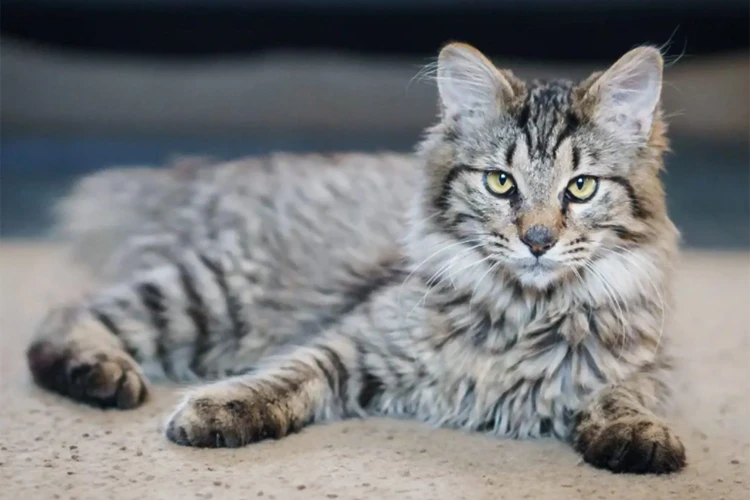
The American Bobtail’s facial characteristics have a fascinating history that is worth exploring. These cats are believed to have originated in the United States, with the first recorded sightings dating back to the 1960s. Initially, they were found in the wild, which meant that their facial characteristics were shaped by natural selection.
The original American Bobtail was a wild cat with a short, bobbed tail that set it apart from other felines. Although the breed had started to appear on the West Coast in the 1960s, it wasn’t until the 1980s that they were recognized as an official breed by The International Cat Association (TICA).
Due to their wild origin, the American Bobtail has a more robust genetic makeup than most other cat breeds. This robust genetic makeup has given them a unique look and distinctive facial characteristics. For instance, they have a strong, square-shaped muzzle, a broad forehead, and large, expressive eyes that make them an attractive breed.
The American Bobtail’s facial features are becoming popular among cat lovers due to their distinctiveness. One of the most distinguishing features of the breed is their eyebrows. The bobtail’s markings on the head, including around the eyes, are quite unique, too. They also have tufted ears that further enhance their overall appeal.
Despite their wild origin, The American Bobtail’s facial characteristics that emerged exude a warm, calm and friendly vibe. They reflect the breed’s personality and give the cat an overall charismatic look, particularly their facial expressions.
Understanding the origins of American Bobtails’ facial characteristics sheds light on their uniqueness and charm. To learn more about American Bobtails’ facial features, check out this detailed guide.
The Original American Bobtail
As we delve into the evolution of the American Bobtail’s facial characteristics, it’s important to understand the origins of this unique breed. The American Bobtail is known for its distinctively short tail and wild appearance, but where did it all begin? The answer lies in the early days of the breed, when the original American Bobtail was first discovered. While there is some mystery surrounding their true origin, historians believe that this breed may have first appeared in the late 1960s in Arizona. To learn more about identifying the facial features of the American Bobtail that set them apart from other breeds, visit identifying-american-bobtail-cat-facial-features.
Genetic Makeup and Facial Characteristics
The American Bobtail’s distinct facial characteristics are determined by its genetic makeup. These cats have a broad head with prominent cheekbones and a strong, square jawline. The nose is slightly curved with a broad base and a noticeable stop. The ears of American Bobtails are medium to large in size, wide at the base, and pointed at the tip.
The American Bobtail’s Facial Characteristics
| Characteristic | Description |
|---|---|
| Head Shape | Strong, square jawline, prominent cheekbones, and broad forehead |
| Nose | Slightly curved with a broad base and noticeable stop |
| Ears | Medium to large in size, wide at the base and pointed at the tip |
The American Bobtail’s eyes are also a distinguishing feature, with a slightly almond shape that slants towards the outer base of the ear. Eye color varies, but the breed standard allows for any color or combination of colors except for blue.
Interestingly, the American Bobtail’s fur patterns and colors are not related to their facial characteristics. Bobtails can come in any pattern or color, including solid, bi-color, tri-color, tortoiseshell, tabby, and pointed.
Understanding the genetic makeup of the American Bobtail is crucial to breeding specific facial characteristics. In the next section, we will learn how breeders have harnessed selective breeding to further enhance the breed’s unique facial features.
Internal link: American Bobtail Genetics and Facial Characteristics
Distinctive Features
American Bobtail is known for its distinctive facial features that set it apart from other cat breeds. Here are some of the most notable facial characteristics of an American Bobtail:
- Eyes: The American Bobtail is known for its large, almond-shaped eyes that are set at a slight angle. Their eyes come in a variety of colors including blue, green, gold, and brown.
- Ears: The ears of an American Bobtail are one of their distinctive features. Their ears are wide and slightly rounded at the tips, often with tufts of hair on the end. Their ears are also slightly tilted forward, which gives them a look of alertness.
- Nose: The nose of an American Bobtail is wide and prominent, giving them a more pronounced snout than other cat breeds. Their nose can be a variety of colors, including pink, black, and brown.
- Muzzle: The muzzle, or snout, of an American Bobtail is also wide and prominent, giving them a distinct look. Their muzzle is broad and square, which makes them look muscular, strong, and wild.
- Musculature: Speaking of muscles, American Bobtails have a very muscular build, especially in their shoulders and hindquarters. Their muscular frame gives them a powerful and athletic appearance.
The distinctive features of an American Bobtail’s face contribute to its wild and unique look, which is sure to turn heads. These features are also coupled with the breed’s charming personality, which is discussed in detail in our article American Bobtail’s Facial Features and Personality. To maintain their distinctive facial features, grooming is crucial, which is discussed in detail in our article AM Bobtail Grooming and Facial Hair. Additionally, the facial expressions of an American Bobtail are nothing short of delightful, which is discussed in detail in our article Facial Expressions of an American Bobtail.
The Development of American Bobtail’s Facial Characteristics
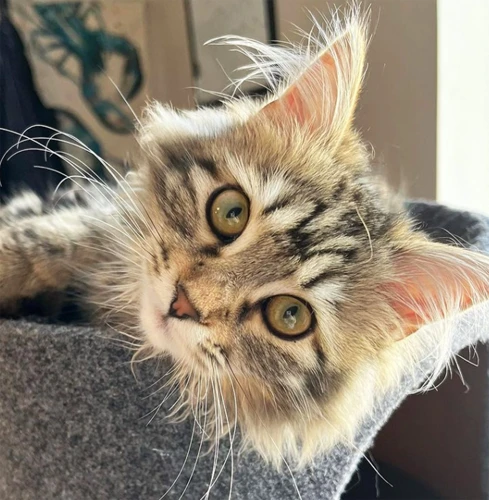
The development of the American Bobtail’s facial characteristics is a fascinating process that has been shaped by various factors.
Mating with other Breeds
One of the main factors that led to the development of the American Bobtail’s facial characteristics is the breed’s tendency to mate with other breeds. As the breed grew in popularity, breeders began to seek out other breeds that had desirable facial characteristics to breed with their Bobtails. This led to a diverse range of facial features in the breed, as features from other breeds were incorporated into the American Bobtail’s genetic makeup.
Selective Breeding
Another factor that has contributed to the development of the American Bobtail’s facial characteristics is selective breeding. Breeders have used a process of selection to choose cats with specific facial features to breed with, in order to produce offspring with desirable characteristics. Over time, this has led to refinement and standardization of the breed’s facial features.
Facial Characteristics that Emerged
As a result of these factors, a number of distinctive facial characteristics have emerged in the American Bobtail breed. These include a strong, broad head with pronounced cheeks and a broad, straight nose. The breed is also known for its expressive eyes, which are large and almond-shaped, and its high cheekbones. The American Bobtail has a short, sturdy neck and a strong, muscular jaw, which gives it a distinctive, powerful appearance.
The development of the American Bobtail’s facial characteristics is an ongoing process that is shaped by a range of factors. As breeders continue to refine and standardize the breed, it is likely that the distinctive facial features of the American Bobtail will continue to evolve and change over time.
Mating with other Breeds
As American Bobtails became more popular, breeders have experimented with different mating combinations in order to enhance certain characteristics of the breed. This practice of crossing breeds is known as outcrossing. Outcrossing with other breeds has resulted in interesting and unique facial expressions for the American Bobtail. However, it is important to understand the potential consequences of such breeding, and the long-term impact on the breed’s facial features.
Selective Breeding
Selective breeding is a practice that has been in existence for centuries, and it has played a crucial role in shaping the current state of American Bobtail’s facial characteristics. This process involves selectively mating cats with desirable facial characteristics to create a new breed that possesses these traits. Breeders aim to produce kittens with prominent cheekbones, strong chins, and wide, round eyes. The table below shows some of the facial characteristics that breeders aim for when carrying out selective breeding.
| Desired Characteristics | |
|---|---|
| Face | Wide at the cheekbones, narrowing towards the muzzle |
| Eyes | Large, round, and set apart |
| Nose | Slightly concave with a gentle dip |
| Chin | Strong and prominent |
Breeders use a range of factors when deciding which cats to mate. They consider the cat’s physical appearance, temperament, and genetic makeup. The breeders also take into consideration the potential health issues that could arise from selective breeding.
Over the years, selective breeding has led to incredible changes in the breed’s facial characteristics. However, it is essential to note that this process can be quite controversial. Breeders have to strike a careful balance between producing cats that are highly desirable while still maintaining the breed’s genetic diversity.
Selective breeding has been a crucial factor in the development of American Bobtail’s facial characteristics. Breeders aim to create kittens that possess the desired traits of a wider face, a slightly concave nose, and prominent cheekbones and chin. Although this process can be quite controversial, the results speak for themselves. The breeders must continue to carefully balance desirable characteristics with maintaining genetic diversity to keep this unique breed healthy and thriving.
Facial Characteristics that Emerged
As the American Bobtail breed continued to develop, several facial characteristics emerged that contributed to their unique appearance. These characteristics include:
- Their broad, round head with a distinct muzzle that gives them a friendly and playful expression.
- Wide-set eyes that come in various shades of brown, amber, and green. Their eyes have an almond shape and are slightly slanted, giving them a wild and untamed look.
- High cheekbones that give their face a sculpted and defined appearance.
- A strong, robust jaw with powerful muscles used for hunting and grabbing prey.
- Ears that are medium-sized and can vary in shape, from slightly curled to straight. They typically have tufts of hair at the tips, adding to their wild and playful look.
These facial characteristics are what give American Bobtails their distinct and desirable appearance. They are a combination of their genetic makeup and the breeding practices that were used to develop the breed.
However, it is important to note that not every American Bobtail will display each of these characteristics in the same way. As with any breed, individual cats can vary in their appearance, reflecting the unique genetic makeup of their parents and ancestors.
The facial characteristics that have emerged in the American Bobtail breed are a testament to the careful breeding and research that has gone into developing this beloved breed. They embody the spirit and personality of these playful, intelligent, and friendly cats, making them a popular choice for many families and cat lovers around the world.
Current State of American Bobtail’s Facial Characteristics
American Bobtail cats continue to be loved by many due to their distinctive appearance and exceptional personality traits. Their facial characteristics, in particular, are a major factor in their appeal. The facial features of American Bobtail cats have remained relatively consistent over the years, but there have been some changes due to selective breeding and other factors.
Standard Characteristics
The American Bobtail is a medium to large-sized cat with a muscular and sturdy build. Their faces are wide and square-shaped, with high cheekbones, a broad nose, and expressive, almond-shaped eyes that are set wide apart. They have a prominent chin and a short, strong neck. The fur on their faces is often thick and plush, framing their features beautifully.
Factors Influencing Changes
There are several factors that have influenced changes in the facial characteristics of American Bobtail cats over the years. One of the most significant factors is selective breeding. Breeders often aim to produce cats with desirable facial characteristics, which can sometimes result in changes to the breed’s appearance over time.
Another factor that has influenced changes in American Bobtail facial characteristics is the introduction of new bloodlines. Sometimes, breeders will introduce new genetic material to a breeding program in order to improve the breed’s overall health and well-being. This can lead to changes in the facial characteristics of American Bobtail cats, as different bloodlines may have distinct facial features.
Finally, environmental factors can also impact the facial characteristics of American Bobtail cats. For instance, nutrition and health can play a significant role in the cat’s overall appearance, including the look of their face. Similarly, exposure to different environments and lifestyle factors can potentially impact how their facial features develop over time.
Future Direction
The future direction of American Bobtail facial characteristics remains unclear. While the breed’s standard facial features have remained relatively stable, there is always the potential for changes as breeders continue to work towards producing cats with desirable traits. Of course, as with any breed, environmental factors will always play a role in the development of the cat’s facial characteristics, and this is not something that can be easily controlled or predicted.
In the end, however, one thing is clear: the distinctive facial characteristics of the American Bobtail are a significant part of what makes them such beloved pets. Their expressive eyes, square faces, and plush fur combine to create a look that is both distinctive and charming. As long as the breed’s unique features are preserved, American Bobtail cats are sure to remain a popular choice among cat lovers for years to come.
Standard Characteristics
When it comes to the appearance of American Bobtails, there are certain features that are considered standard characteristics in the breed. These characteristics give the breed its unique and recognizable appearance, and they are highly valued by breeders and enthusiasts alike. From their facial features to their body shape and size, American Bobtails are distinctive in many ways. In this section, we will explore the standard characteristics of the breed and what makes them so special. So, let’s dive in and discover the defining features of American Bobtails!
Factors Influencing Changes
The American Bobtail’s facial characteristics have evolved over time due to various factors. These factors have had a notable influence on the gradual transformation of the breed’s appearance. Here are some of the key factors that have contributed to this evolution:
- Environmental factors: The environment in which an American Bobtail grows up, including the climate, food, and overall living conditions, can influence their appearance. Environmental factors can affect the cat’s gene expression, leading to changes such as the thickness or color of their fur or the size of their ears.
- Genetic mutations: Genetic mutations occur naturally over time and can give rise to new characteristics or traits. Some American Bobtails may develop unique facial features due to genetic mutations, such as a wider nose or more prominent cheeks. These mutations can be passed down to future generations and contribute to the breed’s evolution.
- Selective breeding practices: The deliberate breeding of American Bobtails with desired traits has been a significant factor in the breed’s evolution. Breeders select cats with specific traits, such as a rounder face or larger eyes, and mate them to produce offspring with similar characteristics. Over time, this selective breeding has resulted in the development of American Bobtails with distinct facial characteristics.
- Interbreeding with other breeds: Crossbreeding with other cat breeds has also played a role in the evolution of the American Bobtail’s facial characteristics. Breeding with other breeds such as the Siamese or the Persian has led to a wider range of eye shapes or snout sizes in resulting offspring.
- Human preferences: Finally, human preferences have also played a role in shaping the American Bobtail’s facial characteristics. As breeders and cat lovers observe the breed over time, they develop preferences for certain traits or characteristics, which they then actively select for through breeding practices.
Various factors have influenced the gradual transformation of the American Bobtail’s facial characteristics over time. From environmental factors to selective breeding practices and human preferences, the evolution of this breed’s appearance has been an ongoing process.
Future Direction
The American Bobtail breed is relatively young and has undergone significant changes over the years. Looking into the future, it is interesting to see the potential direction the breed’s facial characteristics may take. There are several factors that may influence the future direction of American Bobtail’s facial features, including genetics, selective breeding, and external factors such as environmental changes.
One potential future direction of the American Bobtail’s facial characteristics is for the breed to further develop distinctive features that set it apart from other cat breeds. This could include more pronounced eyebrows or wider-set eyes, which could be achieved through selective breeding. According to the Cat Fanciers Association, breeding for improved facial features is already a consideration in the current breed standards.
Another potential direction is for the breed to become more uniform in facial structure, with less variation between individual cats. This could be achieved through stricter breeding standards and a focus on consistency in breeding practices. However, this approach could also result in the loss of some of the unique facial characteristics that make the American Bobtail a distinctive breed.
An interesting aspect of the future direction of the American Bobtail’s facial characteristics is the potential impact of genetic engineering. As technology advances, it may be possible to selectively alter the genes responsible for facial features, allowing breeders to create cats with specific facial characteristics. However, this raises ethical concerns and may be perceived negatively by some members of the cat breeding community.
Table:
| Potential Future Direction | Description |
|---|---|
| Development of More Distinctive Features | Through selective breeding, the breed’s facial features could become more unique, with more pronounced eyebrows or wider-set eyes. |
| Uniform Facial Structure | Stricter breeding standards could result in a more consistent facial structure for the breed, but could also lead to loss of unique features. |
| Potential Impact of Genetic Engineering | Advancements in technology may allow breeders to selectively alter genes to create cats with specific facial characteristics, raising ethical concerns. |
Conclusion
After examining the evolution of American Bobtail’s facial characteristics, it is evident that breeding practices and genetic makeup have played an essential role in shaping the distinctive features that are currently present in the breed. The American Bobtail’s facial characteristics have undergone significant changes, including the emergence of unique features like broad heads and prominent cheeks.
Although the breed has remained relatively consistent in its facial characteristics over the last few decades, there is still scope for further development. Factors such as selective breeding and the influence of environmental factors can contribute to changes in the facial characteristics of the breed.
Despite the possibility of changes occurring, it is important to maintain the breed’s unique physical traits. The American Bobtail is a beloved breed, appreciated for its distinctive features, and it is crucial to preserve its personality and identity.
Having an understanding of the breed’s history and the role of specific breeding practices is essential when identifying the characteristics that make the American Bobtail unique. By maintaining consistency in breeding practices and a focus on breed standards, this beloved breed can continue to captivate admirers with its curious, playful nature and unique physical features.
Frequently Asked Questions
What is an American Bobtail?
An American Bobtail is a unique breed of cat with a short, bobbed tail and distinctive facial characteristics.
What is the origin of the American Bobtail’s facial features?
The American Bobtail’s facial characteristics evolved naturally over time as a result of genetic makeup and environmental factors.
What makes the American Bobtail’s facial features distinctive?
The American Bobtail has a strong, broad, and muscular face with a prominent forehead, large eyes, and a distinct muzzle. Their whisker pads are also prominent and often referred to as “wild” or “lynx-like.”
Did the American Bobtail mate with other breeds?
Yes, the American Bobtail mated with other breeds during its development, which contributed to the diversity and evolution of its facial characteristics.
What is selective breeding?
Selective breeding is the process of choosing individual cats with desirable traits and breeding them to produce offspring with those traits. This can be a way to control and manipulate the evolution of facial characteristics in the American Bobtail breed.
What facial characteristics emerged during the development of the American Bobtail?
During its evolution, the American Bobtail developed a strong, broad face with a prominent forehead, large eyes, and a distinct muzzle. The breed also developed a prominent and unique whisker pad structure.
What are the standard facial characteristics for the American Bobtail?
The American Bobtail breed standards require broad, muscular faces with prominent foreheads, large eyes, and a distinctive muzzle. The whisker pads should also be prominent and have a wild or lynx-like appearance.
What factors influence changes in the American Bobtail’s facial characteristics?
Selective breeding, environmental factors, and the influence of other breeds can all contribute to changes in the American Bobtail’s facial characteristics. Genetic mutations can also have an impact.
Is there ongoing development of the American Bobtail’s facial characteristics?
Yes, the American Bobtail is still evolving and developing new facial characteristics, as breeders selectively breed the cats to emphasize particular traits and diversify the gene pool.
What is the future direction for the American Bobtail’s facial characteristics?
The direction of the future development of the American Bobtail’s facial characteristics is dependent on the breeding practices of those breeding the cats. It is possible that new traits may emerge or that existing traits may be emphasized to create a new breed standard.

